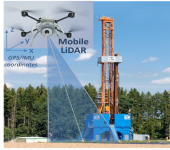Mobile Methane Sensing System

Technology Description:
Bridger Photonics plans to build a mobile methane sensing system capable of surveying a 10 meter by 10 meter well platform in just over five minutes with precision that exceeds existing technologies used for large-scale monitoring. Bridger’s complete light-detection and ranging (LiDAR) remote sensing system will use a novel, near-infrared fiber laser amplifier in a system mounted on a ground vehicle or an unmanned aerial vehicle (UAV), which can be programmed to survey multiple wellpads a day. Data captured by the LiDAR system will provide 3-D topographic and methane absorption imagery using integrated inertial navigation and global positioning system data to show precisely where a methane leak may be occurring and at what rate. This approach will also be used to identify objects on the wellsite to better inform the search optimization. Bridger’s goal is for its devices to be able to service up to 85 sites, and thus cost $1,400 to $2,220 a year to operate per wellsite. By advancing an affordable methane detection system that can both pinpoint and assess leakage quickly, Bridger’s system could help companies repair methane leaks and catalyze an overall reduction in methane emissions from natural gas development.
Potential Impact:
If successful, Bridger would create a mobile methane detection system that can be deployed over long ranges and multiple wellpads at a fraction of the cost of current technologies.
Security:
Better methane detection technologies could improve the sustainability of domestic natural gas production and the safety of operations.
Environment:
Enhanced detection systems could enable greater mitigation of methane leakage and lead to an overall reduction in harmful methane emissions associated with natural gas development.
Economy:
New innovations could decrease the costs of methane detection and help accelerate the adoption of monitoring programs at the nation’s more than 480,000 producing natural gas wells.
Contact
ARPA-E Program Director:
Dr. Joseph King
Project Contact:
Dr. Mike Thorpe
Press and General Inquiries Email:
ARPA-E-Comms@hq.doe.gov
Project Contact Email:
thorpe@bridgerphotonics.com
Partners
Air Force/MIT-Lincoln Laboratory
Related Projects
Release Date:
04/29/2014
